Click on photo to see a larger version.

The Roman Catholic Church's modern-day Ark of the Covenant
(Photo courtesy of Our Lady of Mount Virgin Roman Catholic Church)
|

Horus-Osiris, the ancient Egyptian falcon god
and Buteo ally
(Photo taken from p. 183 of The Egyptian Book of the Dead, with permission of the University of Texas Press and Bristish Museum Press)
|

Buteos and their allies are significant enough to gain a place in both the present-day Roman Catholic Church and the ancient Egyptian religion. Pictured is the lectern of a modern Roman Catholic Church.
(Photo courtesy of Our Lady of Mount Virgin Roman Catholic Church)
|

The Christian representation of the Holy Spirit as a dove is perhaps the most obvious and pervasive modern symbol indicative of avian divinity.
(Photo courtesy of Our Lady of Mount Virgin Roman Catholic Church)
|

In this illustration, Maat even appears to have penetrated the story of Saint George and the Dragon. George wears a Maat-style feather headdress, holds Maat's scales of equity, and is a present-day version of the avian connection to the Divine, as in the Benu-bird, ba, etc.
(Photo courtesy of Our Lady of Mount Virgin Roman Catholic Church)
|
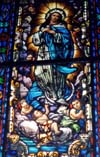
Christians retain the Assumption as a remnant ba concept. Not only is the invisible, spiritual soul retained, but there is also an assumed, holy form, metaphorically rising as if on wings, to heaven.
(Photo courtesy of Our Lady of Mount Virgin Roman Catholic Church)
|
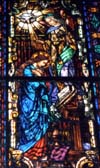
The Visitation occurs in both Roman Catholic and the ancient Egyptian religion, e.g., where there is an announcement by a spiritual paraclete that the divine son will be born of a virgin.
(Photo courtesy of Our Lady of Mount Virgin Roman Catholic Church)
|

Judgment ultimately came from Amen-Re (the origin of our word "Amen") who became identified with Aten during the reign of Akhenaten (Thutmosis IV).
(Photo courtesy of Gerard M. Foley, gfoley@columbus.rr.com. Original in the Luxor Museum, Luxor, Egypt.)
|
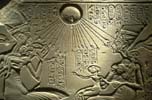
Aten's hands deliver ankhs of life to all whose rays he shines upon - another "Re" metaphor or expression.
|
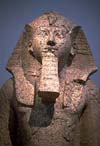
Hatshepsut was the first pharoah to wear the bull's tail, e.g., male dress, while on her throne. The ceremonial "beard" is shown in this figure.
(Photo courtesy of Allan T. Kohl, Minneapolis College of Art & Design/Art Images for College Teaching.)
|
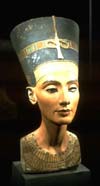
Nefertiti
(Photo courtesy of Allan T. Kohl, Minneapolis College of Art & Design/Art Images for College Teaching.)
|
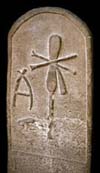
Mermeit
(Photo courtesy of Péter Nagy)
|
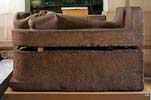
The Sarcophagus of Neterkare
(Courtesy of Jim Dunn, www.touregypt.net; original in the Cairo Antiquities Museum)
|
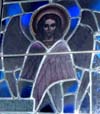
The symbol for the Gospel of Luke, or Ritenbaugh’s Sentient Man
(Photo courtesy of Our Lady of Mount Virgin Roman Catholic Church)
|
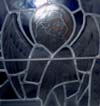
The symbol for the Gospel of Matthew, or Sekhmet
(Photo courtesy of Our Lady of Mount Virgin Roman Catholic Church)
|

The symbol for the Gospel of Mark, or Hathor
(Photo courtesy of Our Lady of Mount Virgin Roman Catholic Church)
|

The symbol for the Gospel of John, Buteo ally as in Horus
(Photo courtesy of Our Lady of Mount Virgin Roman Catholic Church)
|
|